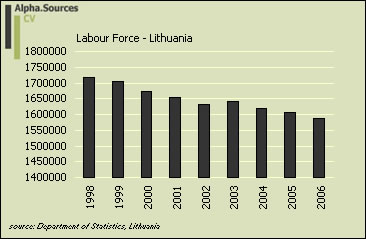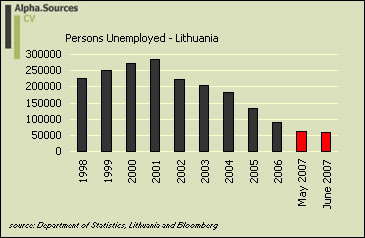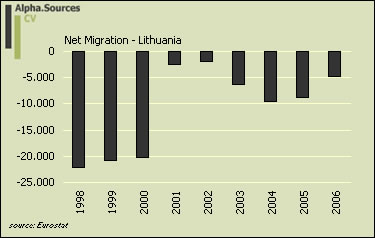The End of the Road In Lithuania?
I am sorry for the rather dramatic headline deployed above but I really don't think that any of this should be taken lightly. I will begin with this short yet very telling note from Bloomberg which informs us that unemployment in Lithuania dropped to a staggering 2.7% in June. This of course signifies an extremely tight labour market and quite simply this cannot go on for much longer. The clear evidence of this is first and foremost to be found in the quarterly y-o-y GDP figures which demonstrate Lithunia's sizzling growth rates much alike the other Baltic countries. As such, Q1 2007 saw an annual growth rate of 8.3% and on average the last five quarters saw a growth rate of GDP of 7.8%. This is of course putting strains of capacity in Lithunia and like in the rest of the Baltic countries the short term cyclical indicators point to very brisk growth in labour costs. Data on Lithuania shows an average increase of a whopping 21.8% in the last four quarters. However, it is the labour force we need to look at I think where Lithuania just can't keep on running up a near vertical hill; and indeed, when the hill turns into a wall the fall might be very far I fear. As such, it might serve us to go back a bit to a post here on AS about the general tendency in net migration in the Baltics. As you can see, outward net migration is particularly pronounced in Lithuania which of course only serves to exacerbate the general sittuation. Below, I field three seperate graphs (two on the labour market and one on net migration) and it should not require much mathematical skill to see how fast this is going in Lithuania and thus how unsustainable it is with the current growth rate. To put the numbers in perspective note that the total population in Lithuania is 3.384.700, that fertility (TFR) has been below 1.5 in more than a decade and that the population (and to some extent also the labour force) is diminishing by means of natural decline. Note especially the figure for unemployed persons which I have expanded with the data from the small Bloomberg piece linked above which notes that the number of unemployed stood at 63.343 in May down to 58.396 in June. In short; this is progressing very quickly indeed, especially if we take into account that the net migration most likely primarily takes its toll from the labour force.



As can readily be seen this is not sustainable much longer with the current growth rates and wage inflation. For a general economic perspective on the Baltic the FT has a nice piece this morning as well as of course Edward's recent note on the Latvian economy (linked above) is a must read. Note in particular how the tug-of-war with the rating agencies as well as Swedish banks supporting the credit boom has begun. People are increasingly beginning to smell a hard landing ahead which is of course prompting market participants to position themselves accordingly. In terms of the general dynamics we might be looking at, this I think is a good quote ...
Nevertheless, the danger facing all three states comes not so much from a collapse of foreign confidence – there is not much speculation in Baltic currencies and the banking sectors and public finances remain solid – as from the impact of any sudden change in consumer behaviour as expectations of continued future growth are dashed. This could lead to a collapse in house prices and a steep economic slowdown.
Such a “hard landing” could stop the three EU newcomers in their tracks as they struggle to catch up with western Europe. Even Estonia, the richest, is still only two-thirds of the EU average gross domestic product (GDP) per capita.
Of course, speculation in Baltic currencies could easily become the flavor of the day if rumours mounted that these countries might have to de-peg from the Euro in order to restore competitiveness. In the end, my advice will be to watch the labour market since the continuous tigtening, not only in Lithuania, at some point will put a ceiling on the current spurt after which the correction will come. Solutions are of course available in terms of bying these economies some time but time, as it were, is indeed running out. Yet, it still seems prudent to advice that inward migration is strongly stimulated and in Lithuania's case where labour force participation rates have been steadily declining for a decade it seems to be a trend which quite simply needs to be reversed although this will be difficult in the immediate short term context.